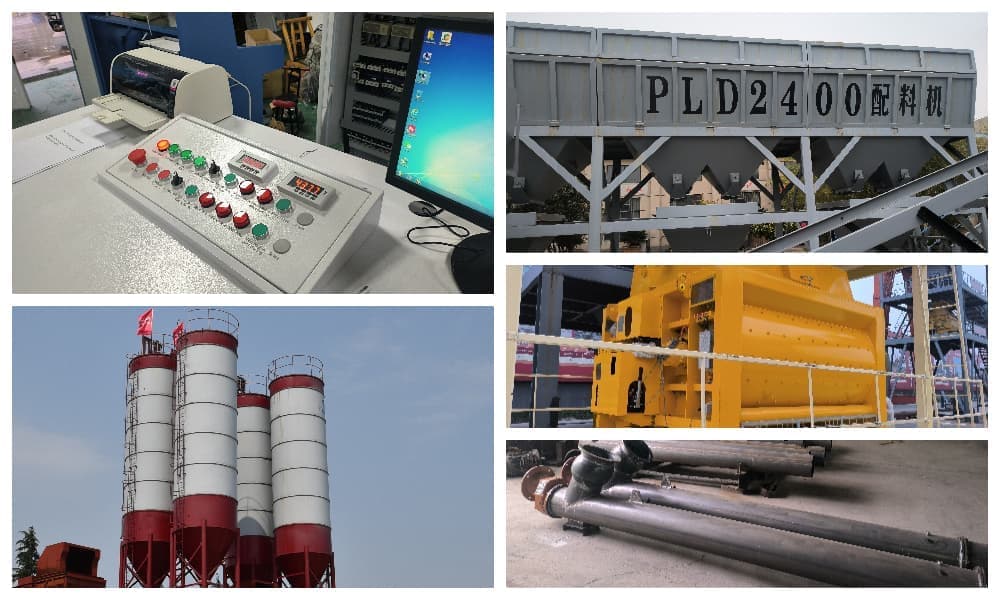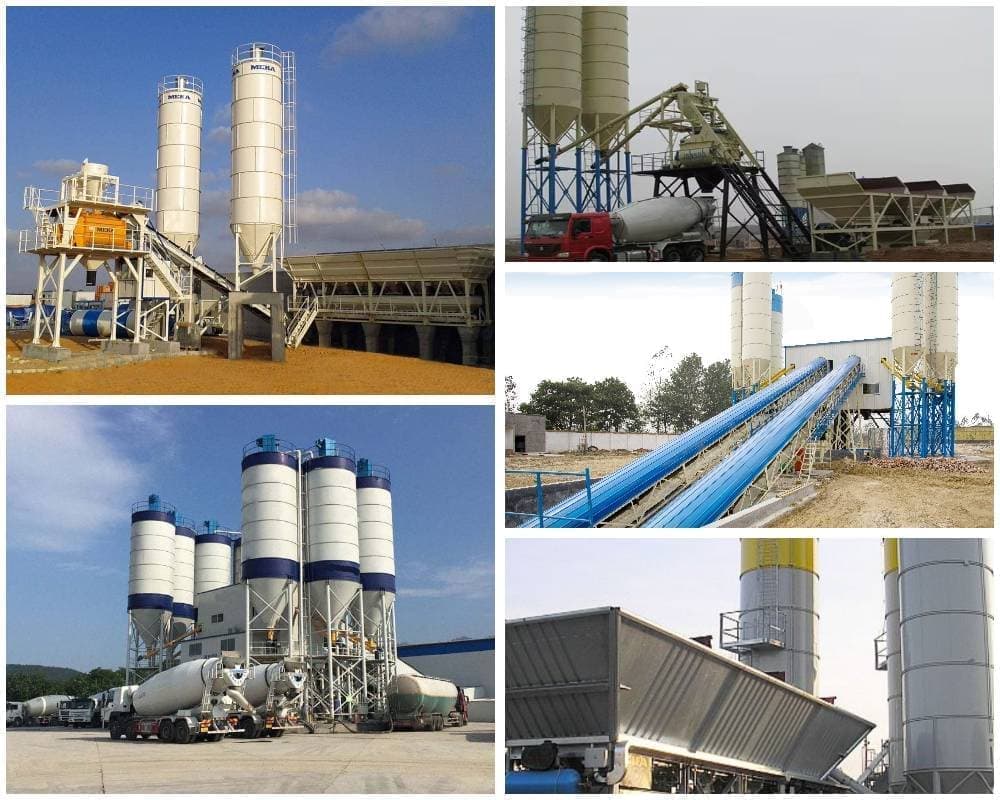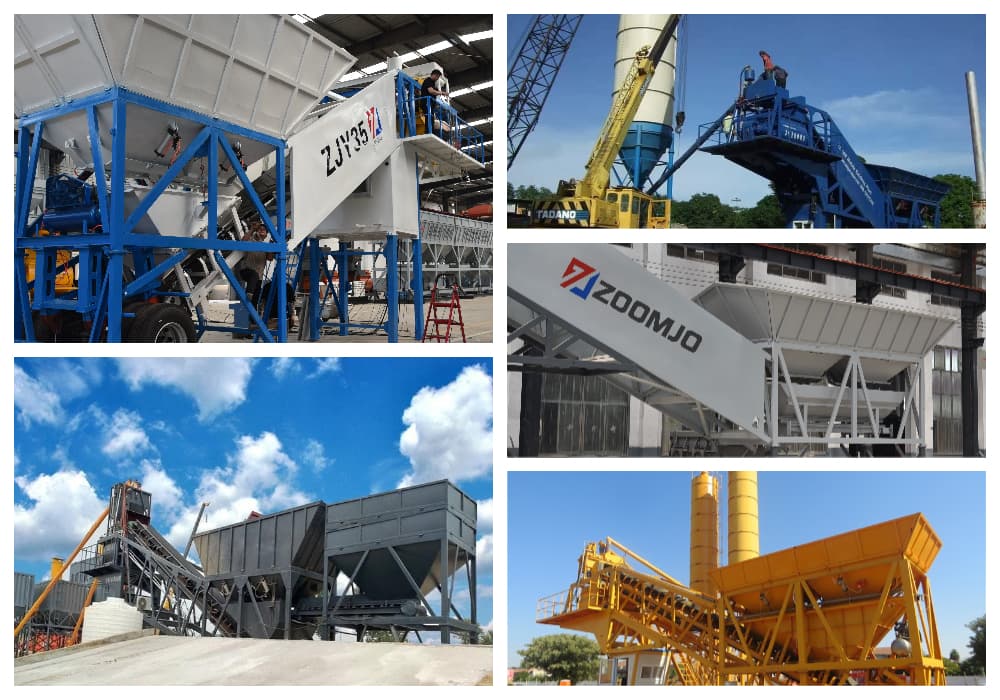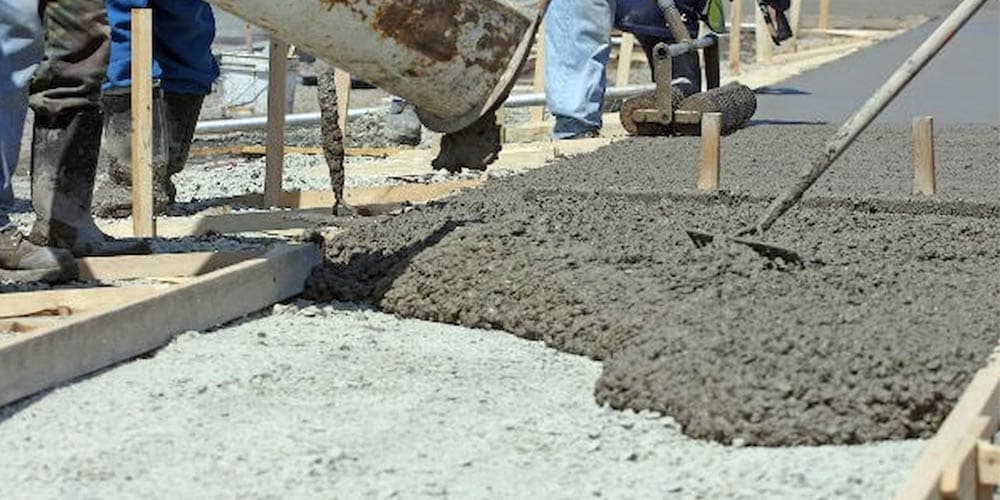How Long does it Take to Make Return On Investment in Concrete Batching Plant?

In the construction industry, investing in a concrete batching plant is a decision that involves a significant capital investment. One of the biggest concerns for investors is: how long is the payback period? This article will provide you with a comprehensive payback period analysis based on industry data and practical experience, and suggest strategies to achieve faster payback.
Standard payback period for a batching plant (theoretical values and practical considerations)
The payback period for a concrete batching plant is relatively short in theory, and under ideal business management and market conditions, costs can usually be recovered within 6-12 months. It should be emphasised that this is a theoretical timeframe and the actual payback period will be affected by a combination of factors. Therefore, investors should not take this as the only reference point but should conduct more in-depth analyses and assessments.
Specifically, taking the stationary concrete mixing plant HZS120 as an example, the theoretical production capacity of this model of mixing plant is 120 cubic metres per hour. Under ideal operating and market conditions, a theoretical production of about 50,000 cubic metres of concrete would be sufficient to achieve payback of the investment cost of the plant. If the mixing plant can work stably for 8 hours a day, and all the concrete produced can be sold in time and in sufficient quantity, the equipment investment cost of the mixing plant itself can theoretically be recovered in about 6 months.
Click to enquire and learn more about concrete batching plant!

Factors affecting the cost recovery time of a mixing plant
Although the theoretical payback period is relatively short, the actual payback period is affected by a combination of factors. The key factors affecting the payback period are analysed in detail below:
Initial investment cost: the cornerstone of investment
-
Purchase cost of equipment: The price of a concrete batching plant varies widely, from $35,000 to $200,000, depending on factors such as production capacity (e.g., hourly output), equipment configuration (e.g., mixer type, accuracy of the batching system), degree of automation, and brand.
-
Other Initial Investments: In addition to equipment acquisition costs, the following one-time inputs need to be considered:
-
Site purchase/rental costs: This includes the cost of land purchase or rental, as well as the cost of site levelling, hardening, etc.
-
Infrastructure construction costs: including water supply, power supply, roads, drainage, environmental protection facilities and other construction costs.
-
Installation and commissioning costs: including the costs of transporting, installing, commissioning and trial operation of the equipment.
-
Pre-operating funds: including the first purchase of raw materials, personnel recruitment and training, and other start-up costs.
Capacity and utilisation: the drivers of profitability
-
Capacity: The theoretical capacity of a batching plant is an important indicator of its profitability potential. Higher capacity means that more concrete can be produced in the same amount of time.
-
Utilisation: Actual production depends on market demand and the efficiency of the plant's operation. The utilisation rate is an important indicator of how efficiently the plant is actually operating. If the market demand is insufficient or the downtime is too long due to equipment failure, maintenance or mismanagement, the utilisation rate of the mixing plant will be lower, thus prolonging the payback period.
The key to improving the utilisation rate is:
-
Effective marketing and sales strategies: Ensure a steady stream of orders.
-
Efficient production management: optimising production processes and reducing downtime.
-
Timely maintenance: Prevent equipment failure and prolong the service life of the equipment.
-
Raw material costs: including cement, sand, aggregate, additives, etc., are the main components of operating costs. The fluctuation of raw material prices will directly affect the operating costs and profit margins.
-
Energy costs: including electricity, fuel, etc., is another important operating costs. Adopting energy-saving equipment and optimising energy management can reduce energy costs.
-
Labour Costs: Includes wages and benefits for operators, managers, technicians, etc. Highly automated equipment can reduce labour costs.
-
Maintenance costs: including routine maintenance, regular maintenance, replacement of wearing parts. Effective maintenance can reduce the failure rate and repair costs.
-
Transportation costs: including the cost of transporting raw materials and finished products. Choosing a site close to the origin of raw materials and target markets can significantly reduce transport costs.
-
Other Operating Costs: Including overheads, taxes, insurance, etc.
Concrete sales price: the key to revenue
-
Market price: The market price of concrete is affected by a variety of factors, including supply and demand in the local market, raw material prices, transport costs, and the competitive environment.
-
Pricing strategy: A sound pricing strategy is critical to ensuring profitability. A combination of costs, market prices and competitor pricing needs to be considered.
Market demand: the impact of the external environment
-
The prosperity of the construction industry has a direct impact on the demand for concrete.
-
Regional economic development: The level of regional economic development and investment in infrastructure construction will also affect the demand for concrete.
-
Seasonal factors: Construction in some regions is strongly influenced by seasonal factors, such as the winter season, when construction is usually reduced, which affects the utilisation rate of mixing plants and their revenues.
Equipment type and maintenance: guaranteeing long-term efficiency
-
Choice of plant type: Different types of mixing plants (e.g. fixed, mobile, skip, belt conveyor) have different scenarios, costs and maintenance requirements. Choosing the right concrete mixing plant can improve operational efficiency and reduce costs.
-
Maintenance: Regular and timely maintenance can reduce the equipment failure rate and prolong the service life of the equipment, thus reducing the repair cost and downtime loss, and accelerating the payback period.
New vs. Used Equipment: Weighing the Pros and Cons
-
New equipment: Although the initial investment in new equipment is higher, it usually offers higher productivity, lower failure rates, longer service life and better after-sales service.
-
Second-hand equipment: Buying second-hand equipment reduces the initial investment, but also involves quality risks, dismantling and reassembly costs, and inadequate after-sales service. The condition of the used equipment and the reputation of the seller need to be carefully assessed.
By analysing the above in more detail, investors can gain a fuller understanding of the various factors affecting the payback period of a concrete batching plant, and thus make a more informed investment decision.
In order to achieve faster payback, we provide all-round strategic advice. From market research to concrete batching plant configuration, we can provide you with professional guidance. Contact us today and let us help you boost your ROI.
Suggestions for Improving ROI on Concrete Batching Plants
To achieve faster payback, investors should adopt the following all-encompassing strategies:
Precise positioning and size allocation:
-
Market research first: conduct sufficient market research before investment to understand the local construction market demand, competitive landscape, concrete prices, supply of raw materials and so on.
-
Demand-oriented scale selection: According to the type, scale and duration of the project, as well as the expected demand for concrete, select the appropriate scale of the mixing plant (e.g., choose HZS25/35 for small-sized projects, HZS50/75/90 for medium-sized projects, HZS120 or above for large-sized projects). Avoid blindly pursuing large-scale equipment leading to over-investment, or choosing too small equipment that cannot meet the demand.
-
Optimise equipment configuration: According to the requirements of the project on concrete performance (e.g. strength grade, ease of use, durability), choose the right type of mixer (e.g. double horizontal axis forced mixer, planetary mixer), the accuracy of the batching system, and the degree of automation of the control system. Under the premise of meeting the requirements, try to choose a cost-effective configuration.
Equipment quality and efficiency are given equal importance:
-
Prefer well-known brands: Choose reputable, mature technology and reliable quality equipment of well-known brands to reduce failure rate, improve productivity and extend service life. Although the initial investment may be higher, maintenance costs and downtime losses can be reduced in the long run.
-
Focus on energy saving and environmental protection: Choose energy-saving mixers, conveying systems and control systems to reduce energy consumption and operating costs. At the same time, it should meet the requirements of local environmental regulations to reduce environmental pollution.
-
Automation and Intelligence: Consider adopting equipment with high degree of automation and intelligent control to improve production efficiency, reduce labour costs and improve the stability of concrete quality.
Refined operation cost control:
-
Raw material procurement management: Establish stable raw material supply channels, establish long-term cooperation with suppliers and strive for preferential prices. At the same time, strengthen the quality control of raw materials to reduce waste.
-
Energy management: Optimise the production process to reduce energy waste. For example, reasonable arrangement of production plan to avoid equipment idling; the use of energy-saving equipment, such as frequency conversion motors, high-efficiency lighting and so on.
-
Labour cost control: Control labour cost by optimizing staffing, improving staff skills and adopting automated equipment.
-
Maintenance management: establish a perfect equipment maintenance system, regular inspection and maintenance, timely replacement of wear parts, prevention of equipment failure, prolong the service life of the equipment.
-
Logistics optimisation: Optimise the transport routes and methods of raw materials and finished products to reduce transport costs.
Expanding the source of stable orders:
-
Establish long-term partnership: establish long-term and stable partnership with construction companies, real estate developers, infrastructure construction units, etc., a stable source of orders, and improve the equipment utilisation rate.
-
Diversify customer groups: In addition to large-scale projects, we should also actively expand small and medium-sized projects and retail customers to diversify market risks.
Perfect after-sales service system:
-
Select quality equipment suppliers: Select manufacturers that provide comprehensive and timely after-sales service (including equipment installation and commissioning, operation training, maintenance, spare parts supply, etc.) to ensure efficient and stable operation of the equipment throughout its life cycle.
-
Establishment of their own maintenance team: the formation of a professional maintenance team, responsible for the daily maintenance of equipment and simple repairs to shorten the troubleshooting time, reduce downtime losses.
Scientific and reasonable site selection:
-
Close to the origin of raw materials: shorten the transport distance of raw materials, reduce transport costs.
-
Convenient traffic: Convenient for the transport of raw materials and finished products, improve logistics efficiency.
-
Away from residential areas: Reduce the impact of noise and dust pollution on the surrounding environment and avoid disputes.
-
Perfect infrastructure: Adequate water supply, power supply and drainage to meet production needs.
-
Compliance with planning and regulations: The site selection should be in line with local land use planning, environmental protection regulations and safe production requirements.
These recommendations are more practical guidance, can effectively help investors to improve the return on investment of concrete batching plant.
How to choose a concrete batching plant: key decisions affecting return on investment
As analysed earlier, the purchase cost and operational efficiency of a concrete batching plant directly affect the payback cycle. Therefore, choosing the right concrete batching plant is not only an important purchasing decision, but also a key factor affecting the return on investment.
The next section will discuss in detail around how to choose the most suitable concrete batching plant for you based on project requirements, budget and long-term operational goals.
1. Define project requirements: the basis for selection
Determine the scale of production and concrete requirements:
-
Project type and scale: Define the project type (e.g. building, bridge, road, water conservancy, etc.) and scale (e.g. volume of work, duration, concrete strength grade requirements, etc.), which will directly affect the demand for concrete, production speed and quality requirements. For example, high-rise buildings require higher strength and pumping performance of concrete.
-
Concrete demand: According to the project drawings, construction plan and concrete ratio, the total amount of concrete required and the peak demand are accurately estimated. This determines the production capacity of the mixing plant (e.g. hourly output, commonly used models are HZS25, HZS35, HZS50, HZS75, HZS90, HZS120, HZS180, etc.).
-
Duration: The duration of the project will affect the continuous working ability, stability and maintenance requirements of the mixing plant. Long-term projects require more durable and reliable equipment.
-
Special Concrete Requirements: Whether there is a need to produce special concrete, such as high-performance concrete, fibre concrete, self-compacting concrete, etc., which will affect the configuration of the mixing plant, such as the need for additional additive batching systems.
2. Choosing the right type of mixing plant: meeting different needs
Choosing the right type of mixing plant:
-
Fixed mixing plant: Suitable for large-scale and long-term projects with strong production capacity, high degree of automation and high metering precision, but with higher installation and dismantling costs and larger floor space. Suitable for large-scale commercial concrete mixing plant or large-scale engineering projects.
-
Mobile mixing plant: It is suitable for projects with short construction period, unfixed site and frequent transfer, with convenient movement, high flexibility and small floor space, but with relatively low production capacity. It is suitable for small-scale projects or field construction.
The following is the comparison table of stationary concrete mixing plant and mobile concrete mixing plant:
| Comparison items | Stationary Concrete Batching Plant | Mobile Concrete Batching Plant |
|---|---|---|
| Definition | Installed in a fixed location to serve a specific area or project for a long period of time. | Can be dismantled and transferred at any time, suitable for short-term or multi-project construction needs. |
| Applicable Scenarios | Large-scale long-term projects, such as urban construction, commercial development, bridges, etc. | Temporary projects, multi-location construction, such as road construction, field works, etc. |
| Installation and Construction | Requires foundation and site construction, long installation period (usually 2-4 weeks). | No foundation required, quick installation (usually 1-2 days). |
| Mobility | Fixed and immobile, high dismantling and shifting costs. | All-in-one design, can be quickly disassembled and transferred, high mobility. |
| Equipment cost | Relatively low, suitable for mass production needs. | Higher, increased cost due to complex design and incorporation of mobility features. |
| Maintenance costs | Lower, more economical for long term operation and easy maintenance. | Higher, frequent movement may lead to increased wear and tear of components. |
| Production capacity | Typically higher capacity, suitable for continuous, high-intensity production tasks. | Production capacity is usually small, but adaptable and suitable for flexible and changing working conditions. |
| Floor space | Large footprint, requiring specialised site planning. | Smaller footprint, more space efficient. |
| Transport costs | Requires fixed site for transporting raw materials and concrete, higher transport costs. | Can be moved to near the raw materials or construction site, saving transport costs. |
| Environmental performance | Can be equipped with perfect environmental protection facilities to reduce dust and noise pollution. | Environmental protection facilities may be simpler due to temporary use. |
| Service life | Long service life, suitable for long-term investment. | The service life may be slightly shorter than that of stationary equipment due to the high frequency of movement. |
| Payback period | Suitable for long-term use, with a short payback period. | Initial investment is higher and payback period is affected by project scheduling. |
| Operator Requirements | Requires a fixed operating team with a more standardised process. | Flexible operator requirements, need to adapt to changes in working conditions at multiple locations. |
| Expandability | The production line can be increased according to the demand, and the expansion is flexible. | Expandability is limited and usually operates as a stand-alone machine. |
If you are going to undertake a large-scale bridge construction project with a long construction period and a large demand for concrete, then you need to choose a stationary forced mixing plant with strong production capacity, high stability and a high degree of automation. If the project site is scattered and the construction period is short, then you can choose multiple mobile mixing plants.
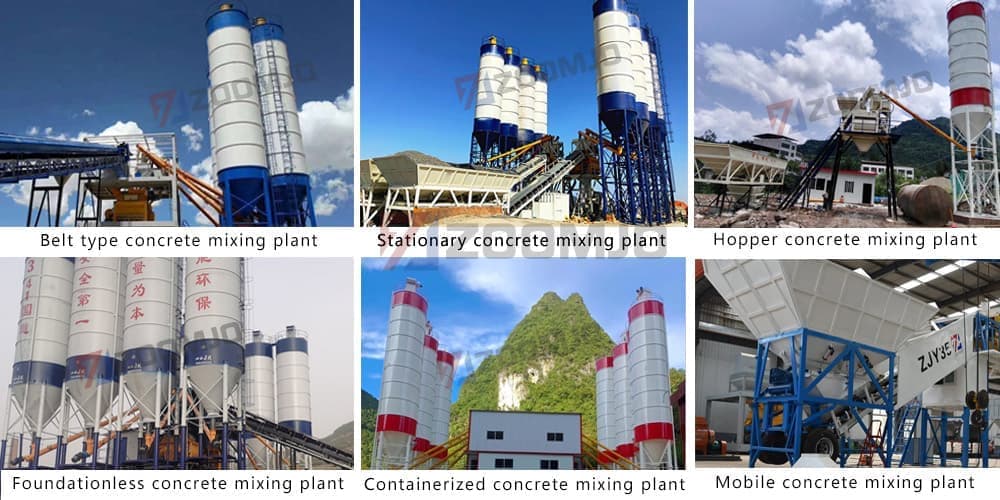
3. Consider site conditions: ensure smooth operation
Consider site conditions:
-
Site size and topography: The installation of the mixing plant requires a certain site space, and the size, flatness, bearing capacity and geological conditions of the site need to be considered. It is very important to carry out geological survey in advance.
-
Traffic conditions: The site should have convenient traffic, which is convenient for the transport of raw materials and the output of finished products to avoid traffic congestion affecting the construction progress. Consider the carrying capacity and width of the road.
-
Water and electricity supply: The mixing plant needs stable water supply and power supply, and it is necessary to consider the water and electricity supply of the site, including the quality and quantity of water supply, the voltage and capacity of power supply. If necessary, it is necessary to increase the capacity or provide its own generator.
-
Environmental Protection Requirements: The site should meet the requirements of local environmental protection regulations, such as noise, dust, and wastewater discharge. Corresponding environmental protection measures need to be taken, such as installing dust removal equipment, sound insulation facilities, and sewage treatment systems.
4. Evaluating equipment performance and configuration: focusing on core components
Evaluate equipment performance and configuration:
-
Mixing machine: It is the core equipment of the mixing plant, and you need to choose the appropriate model and specification according to the type of concrete, output and mixing performance requirements. Pay attention to the material and wear resistance of the mixer's liner and blades and other wear parts.
-
Batching system: including aggregate batching machine, cement batching machine, water batching machine, additive batching machine, etc., need to ensure the accuracy and efficiency of batching. Adopt electronic scale to measure and calibrate regularly.
-
Conveying system: including belt conveyor, screw conveyor, elevator, etc., need to ensure the efficiency and stability of material conveying, avoid material leakage and blockage.
-
Control system: The use of a high degree of automation control system can improve production efficiency, reduce labour costs and improve the stability of concrete quality. Pay attention to the brand, function and reliability of the control system.
-
Measuring accuracy: Ensure that the measuring accuracy of various materials meets the national standards to ensure the quality of concrete. Pay attention to the precision and stability of the sensor.
5. Choose a reputable supplier: guarantee after-sales service.
Choose a reputable supplier:
-
Supplier qualification: Choose suppliers with good reputation, rich experience and production qualification to guarantee the quality of equipment and after-sales service. Examine the production scale, technical strength and customer reputation of the supplier.
-
After-sales service: Understand the supplier's after-sales service policy, including equipment installation and commissioning, operation training, maintenance, spare parts supply. Choose suppliers who provide timely, efficient and professional after-sales service to reduce losses caused by equipment failure.
Frequently Asked Questions about Concrete Batching Plants
Q: How to choose the right concrete batching plant supplier?
A: Choosing suppliers need to consider their qualification, reputation, technical strength, production scale, after-sales service and other aspects. It is recommended to choose suppliers with rich experience, good reputation and perfect after-sales service system.
Q: Is it cost-effective to buy used concrete batching plant?
A: While purchasing a used batching plant may save on the initial investment, potential quality issues, the cost of dismantling and re-installation, and the risk of lack of after-sales service may make this option uneconomical. Investors are usually advised to choose a brand new plant to ensure quality and follow-up support.
Q: Which concrete mixer should I choose for my mixing plant?
A: Generally speaking, if your mixing plant needs to produce many types of concrete or has high quality requirements for concrete, then a forced mixer is a better choice. If your mixing plant is only used for small projects to produce simple flowable concrete and has a limited budget, then consider choosing a self-fall mixer.
Q: What factors should be considered for the location of a concrete batching plant?
A: The location of concrete batching plant should be close to the place of raw material supply in order to reduce the transport cost and time. In addition, the site selection should also consider the accessibility of electricity and water sources, traffic conditions, flatness of the terrain and compliance with the relevant procedures for industrial land.
Q: What types of concrete can be produced in a concrete batching plant?
A: Concrete batching plants are capable of producing a wide range of concrete types, from the most commonly used ordinary concrete (for general construction) to high-performance concrete with higher strength and durability (for high-rise buildings, bridges, etc.), as well as a series of special concretes with special properties, such as fibre concrete with fibre reinforcement for anti-cracking and anti-impact resistance, self-compacting concrete with good liquidity and no need for vibration, lightweight aggregate concrete for heat insulation, impermeable concrete with good waterproofing properties, and coloured concrete for decoration. Lightweight aggregate concrete for thermal insulation, impermeable concrete for waterproofing, and coloured concrete for decoration.
Q: What kind of concrete can be produced in a concrete batching plant?
A: Concrete batching plants can produce many types of concrete, including dry hard concrete, plastic concrete, flowable concrete, lightweight concrete and self-compacting concrete. These concrete types can meet the specific needs of different projects, ensuring construction quality and efficiency.
Q: Can each batching plant produce all types of concrete?
A: No. The production capacity depends on the equipment level of the batching plant. Production capacity depends on the level of equipment in the batching plant , and small simple batching plants are generally only capable of producing normal concrete. High-performance and speciality concretes require more specialised equipment.

 English
English  Español
Español  简体中文
简体中文  Pусский
Pусский  українська
українська 